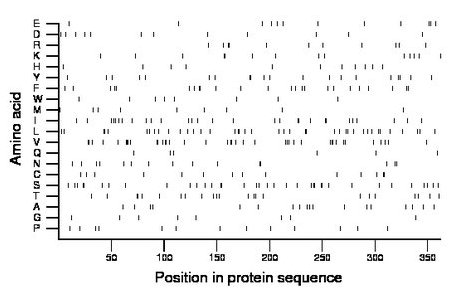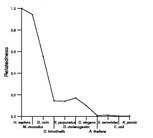
| Name: CXCR7 | Sequence: fasta or formatted (362aa) | NCBI GI: 31083344 | |
|
Description: chemokine orphan receptor 1
|
Referenced in: Chemokines and Their Receptors
| ||
|
Composition:

Amino acid Percentage Count Longest homopolymer A alanine 5.0 18 1 C cysteine 3.9 14 2 D aspartate 3.3 12 1 E glutamate 3.3 12 1 F phenylalanine 6.6 24 2 G glycine 2.2 8 1 H histidine 3.0 11 1 I isoleucine 8.0 29 2 K lysine 3.9 14 2 L leucine 11.0 40 2 M methionine 2.5 9 1 N asparagine 4.1 15 2 P proline 3.6 13 1 Q glutamine 1.7 6 1 R arginine 3.0 11 2 S serine 9.9 36 2 T threonine 6.4 23 2 V valine 10.8 39 3 W tryptophan 2.2 8 1 Y tyrosine 5.5 20 2 |
Comparative genomics:
Search single species RefSeq proteins at NCBI
Search summary 
Figure data | ||
Related human proteins:Protein Relative score Description Self-match 1.000 chemokine orphan receptor 1 GPR182 0.248 G protein-coupled receptor 182 IL8RB 0.220 interleukin 8 receptor beta AGTR1 0.218 angiotensin II receptor, type 1 AGTR1 0.218 angiotensin II receptor, type 1 AGTR1 0.218 angiotensin II receptor, type 1 AGTR1 0.218 angiotensin II receptor, type 1 AGTR1 0.218 angiotensin II receptor, type 1 CXCR4 0.214 chemokine (C-X-C motif) receptor 4 isoform b CXCR4 0.214 chemokine (C-X-C motif) receptor 4 isoform a IL8RA 0.214 interleukin 8 receptor alpha CCR1 0.199 chemokine (C-C motif) receptor 1 CX3CR1 0.199 chemokine (C-X3-C motif) receptor 1 CCRL1 0.196 chemokine (C-C motif) receptor-like 1 CCRL1 0.196 chemokine (C-C motif) receptor-like 1 CCR7 0.196 chemokine (C-C motif) receptor 7 precursor CXCR3 0.194 chemokine (C-X-C motif) receptor 3 isoform B CXCR3 0.194 chemokine (C-X-C motif) receptor 3 isoform A CCR4 0.194 chemokine (C-C motif) receptor 4 SSTR1 0.190 somatostatin receptor 1 AGTR2 0.189 angiotensin II receptor, type 2 CCR8 0.189 chemokine (C-C motif) receptor 8 CCR5 0.187 chemokine (C-C motif) receptor 5 CCR5 0.187 chemokine (C-C motif) receptor 5 CCR3 0.185 CC chemokine receptor 3 CCR3 0.185 CC chemokine receptor 3 CCR2 0.182 chemokine (C-C motif) receptor 2 isoform B LPAR6 0.182 G-protein coupled purinergic receptor P2Y5 LPAR6 0.182 G-protein coupled purinergic receptor P2Y5 LPAR6 0.182 G-protein coupled purinergic receptor P2Y5Human BLASTP results (used to prepare the table) | |||
Gene descriptions are from NCBI RefSeq. Search results were obtained with NCBI BLAST and RefSeq entries. When identical proteins are present, the self-match may not be listed first in BLASTP output. In such cases, the table above has been reordered to place it first.
See About the Figures for the scoring system used in the figure above right. The same scoring system was used in the table of BLASTP results.
Guide to the Human Genome
Copyright © 2010 by Stewart Scherer. All rights reserved.
